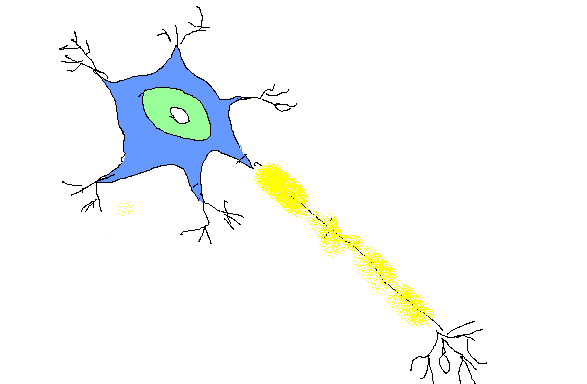

The squid giant axon, which is specialized to conduct signals very rapidly, is close to 1 millimeter in diameter, the size of a small pencil lead. The largest mammalian axons can reach a diameter of up to 20 µm. Most individual axons are microscopic in diameter (typically about one micrometer (µm) across). The longest axons in the human body are those of the sciatic nerve, which run from the base of the spinal cord to the big toe of each foot.

Some axons can extend up to one meter or more while others extend as little as one millimeter. Anatomy A typical myelinated axon A dissected human brain, showing grey matter and white matterĪxons are the primary transmission lines of the nervous system, and as bundles they form nerves. In placental mammals the largest white matter tract in the brain is the corpus callosum, formed of some 200 million axons in the human brain. A bundle of axons make a nerve tract in the central nervous system, and a fascicle in the peripheral nervous system. Other synapses appear as terminals at the ends of axonal branches.Ī single axon, with all its branches taken together, can target multiple parts of the brain and generate thousands of synaptic terminals. Some synaptic junctions appear along the length of an axon as it extends these are called en passant ("in passing") synapses and can be in the hundreds or even the thousands along one axon. At a synapse, the membrane of the axon closely adjoins the membrane of the target cell, and special molecular structures serve to transmit electrical or electrochemical signals across the gap. In some circumstances, the axon of one neuron may form a synapse with the dendrites of the same neuron, resulting in an autapse. Axons make contact with other cells – usually other neurons but sometimes muscle or gland cells – at junctions called synapses. The swollen end of a telodendron is known as the axon terminal which joins the dendrite or cell body of another neuron forming a synaptic connection. The end branches of an axon are called telodendria. Most axons branch, in some cases very profusely. Īxons are covered by a membrane known as an axolemma the cytoplasm of an axon is called axoplasm. No neuron ever has more than one axon however in invertebrates such as insects or leeches the axon sometimes consists of several regions that function more or less independently of each other. In some species, axons can emanate from dendrites known as axon-carrying dendrites. Some types of neurons have no axon and transmit signals from their dendrites. Axons are distinguished from dendrites by several features, including shape (dendrites often taper while axons usually maintain a constant radius), length (dendrites are restricted to a small region around the cell body while axons can be much longer), and function (dendrites receive signals whereas axons transmit them). Another classification groups only the sensory fibers as Type I, Type II, Type III, and Type IV.Īn axon is one of two types of cytoplasmic protrusions from the cell body of a neuron the other type is a dendrite.

These groups include both sensory fibers and motor fibers. Groups A and B are myelinated, and group C are unmyelinated. Nerve fibers are classed into three types – group A nerve fibers, group B nerve fibers, and group C nerve fibers. Axon dysfunction can be the cause of many inherited and acquired neurological disorders that affect both the peripheral and central neurons. In certain sensory neurons ( pseudounipolar neurons), such as those for touch and warmth, the axons are called afferent nerve fibers and the electrical impulse travels along these from the periphery to the cell body and from the cell body to the spinal cord along another branch of the same axon. The function of the axon is to transmit information to different neurons, muscles, and glands. An axon (from Greek ἄξων áxōn, axis), or nerve fiber (or nerve fibre: see spelling differences), is a long, slender projection of a nerve cell, or neuron, in vertebrates, that typically conducts electrical impulses known as action potentials away from the nerve cell body.


 0 kommentar(er)
0 kommentar(er)
